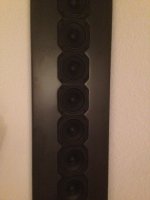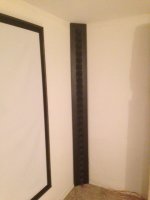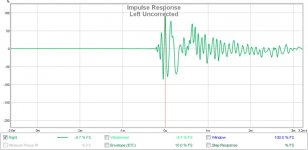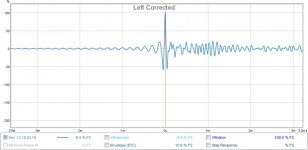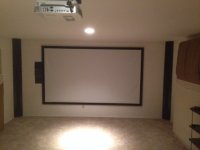Thanks for the response and the links. I tried the JRiver medium enhancement and it is a nice effect. It brought the sound out from between the speakers to outside the speakers. But it leaves a hole to the left and right of the center phantom image. Sort of like someone took the image and moved nearer to the speakers and away from the center. I don't know if I like it or not, but definitely interesting.
That's how it started for me 😀.
So I brought it down a bit by including the Voxengo MSED plugin, boosting the mid channel from the mid/side processing. This eats away some of the effect but closes the gap. Also playing with toe-in helped get a believable stage. But the sides always shined more in vocal clarity when using (some of) the effect compared to without.
That made me pursue even more options. I'm still searching for a way of processing which doesn't boost the sides as much but still contains the part acting like crosstalk cancelation.
Fast forward to this week I'm more and more convinced if the phantom centre is processed similar/the same as what that JRiver effect does for the sides it will be worth it. But there's only so much one can do with the audio signal. Yet if you look at what the average crosstalk algorithms do I'm only scratching the surface. Yet the effect is pronounced. At one time I had the crosstalk level in the phantom centre at about -9 dB. That's the clearest I've heard the vocals, the rest of the stage was a mess though. The background vocals were beside me etc...
What I have now is a tuned down JRiver effect by boosting the mid with MSED by ~1.6 dB, a slight mid side adjustment in EQ and the left + right signal combined, phase inverted and band passed at 350, 12 dB/Oct and 7500, 12 dB/oct, delayed 0.270 ms and inserted back at -21 dB to left and right signal. The phase inverted copy is -15 dB down from the main signal in my test file.
I let my girlfriend listen, she hadn't taken the time to do that for quite a while. The plan was to let her listen to only one song. Before I went out for groceries we had already listened to 5/6 songs together and when I came back more than half an hour later the music was still blasting full power and she was having the time of her life 🙂. So it definitely did something to keep her attention. She never got it why I did what I did. But this taste left her craving for more.
Last edited:
The problem is that there are no recording standards, so one cannot apply the effect and expect similar results on every recording. That's what I experienced. Some recordings were enriched by the effect, others didn't take to it so much.
Have you listened to your speakers without any processing since you have honed in on the current set up? I wonder how they sound in comparison. It would be interesting to hear you describe the difference. They may be "unlistenable" to you now. It would be interesting to hear how you now describe the raw sound compared to your description of the sound right after completing them ( before starting the "processing" process.)
Last edited:
The problem is that there are no recording standards, so one cannot apply the effect and expect similar results on every recording. That's what I experienced. Some recordings were enriched by the effect, others didn't take to it so much.
True, to some extend. But I've compared what I have on several recordings, with and without the effect. With my setup I prefer to have (some of) it on.
What I said, the amount of toe in matters too! With speakers pointed straight on axis to the listening spot it didn't work as good. I have them cross behind me, though I would have wanted to cross before me at similar angles. My room does not allow that, so crossing behind is the best option left.
It makes a lot of music shine, most recordings do benefit. But some more that others.
Have you listened to your speakers without any processing since you have honed in on the current set up? I wonder how they sound in comparison. It would be interesting to hear you describe the difference. They may be "unlistenable" to you now. It would be interesting to hear how you now describe the raw sound compared to your description of the sound right after completing them ( before starting the "processing" process.)
It would depend a little on what you'd call the raw sound. Without any EQ you have no bass, way too much energy at ~200 Hz and a downwards slope above. But, it already displays a potential in the midrange. I used to use it like this for TV sound reinforcement. I can't anymore though, now that I'm used to something better.
Next step, throw in the Pré EQ I use before entering FIR correction: this starts to sound pretty decent. A bit wild but highly entertaining. Not as nice on everything as it will exaggerate parts that don't need it and vice versa. The energy is very captivating though. But it is a lot to take in.
Throw in the FIR correction, it will tone down the wild energy, make the tonal balance behave and imaging starts to come to life. Yet it can be quite a big difference compared to the raw EQ. I might start to miss some of that raw power if I had to stop here.
The ambient channels and (let's call it: ) crosstalk cancelling make the picture created by the FIR correction more complete, more 3D and more real. It even adds back a bit of that feeling of the raw response, more entertaining and exhilarating than FIR correction alone, yet remains precise. It draws me into the music.
I have no doubt I prefer the full DSP treatment, but the raw energy one is still quite listenable. Perhaps more tiring in the long end. Not everything sounds as pleasing with this raw EQ version... it is a bit too restless and lacking in the finesses.
Hope this will do as an answer. A better EQ job than my very global raw EQ could go a long way. But the FIR correction is tough to beat. The rest of what I do is for learning and education but it did make something that's quite good by itself even better i.m.h.o. More involving, more like it's happening right there in front of you, the "you are there" part comes to mind. With eyes closed my room feels way bigger (or disappears completely depending on the recording) than it actually is and you hear the boundaries in the recording (when present).
It excels at painting the picture so far.
A few weeks ago I was pretty pleased, done I said some pages back. Yet there was still more to try. I'm just trying different theories. Maybe even creating some new ones as I go in this process of learning. I do believe the well behaved FIR correction I managed to obtain to be the key of the success of these add-ons I'm currently trying. The reflection free (not exactly free but down by more than -15/-20 dB) first 20 ms gives room to experiment with phase inverted copies 15 dB or more below the main signal.
Everywhere I go and something is playing I listen, listening to learn. But only in my room I'm overly critical when listening. The more I lose that by getting caught up in the moment, the music, the more I know I'm reaching my destination. This happens quite often I'm glad to say, getting lost in the music is what I build these for. A lot of smiles per hour... 😀 Time does fly this way though.
Last edited:
😀Everywhere I go and something is playing I listen, listening to learn. But only in my room I'm overly critical when listening. The more I lose that by getting caught up in the moment, the music, the more I know I'm reaching my destination. This happens quite often I'm glad to say, getting lost in the music is what I build these for. A lot of smiles per hour... 😀 Time does fly this way though.
Excatly. No matter the technology involved and how far you are in you quest - this is it!!
It would depend a little on what you'd call the raw sound. Without any EQ you have no bass, way too much energy at ~200 Hz and a downwards slope above. But, it already displays a potential in the midrange. I used to use it like this for TV sound reinforcement. I can't anymore though, now that I'm used to something better.
Next step, throw in the Pré EQ I use before entering FIR correction: this starts to sound pretty decent. A bit wild but highly entertaining. Not as nice on everything as it will exaggerate parts that don't need it and vice versa. The energy is very captivating though. But it is a lot to take in.
Throw in the FIR correction, it will tone down the wild energy, make the tonal balance behave and imaging starts to come to life. Yet it can be quite a big difference compared to the raw EQ. I might start to miss some of that raw power if I had to stop here.
The ambient channels and (let's call it: ) crosstalk cancelling make the picture created by the FIR correction more complete, more 3D and more real. It even adds back a bit of that feeling of the raw response, more entertaining and exhilarating than FIR correction alone, yet remains precise. It draws me into the music.
I have no doubt I prefer the full DSP treatment, but the raw energy one is still quite listenable. Perhaps more tiring in the long end. Not everything sounds as pleasing with this raw EQ version... it is a bit too restless and lacking in the finesses.
Hope this will do as an answer. A better EQ job than my very global raw EQ could go a long way. But the FIR correction is tough to beat. The rest of what I do is for learning and education but it did make something that's quite good by itself even better i.m.h.o. More involving, more like it's happening right there in front of you, the "you are there" part comes to mind. With eyes closed my room feels way bigger (or disappears completely depending on the recording) than it actually is and you hear the boundaries in the recording (when present).
It excels at painting the picture so far.
A few weeks ago I was pretty pleased, done I said some pages back. Yet there was still more to try. I'm just trying different theories. Maybe even creating some new ones as I go in this process of learning. I do believe the well behaved FIR correction I managed to obtain to be the key of the success of these add-ons I'm currently trying. The reflection free (not exactly free but down by more than -15/-20 dB) first 20 ms gives room to experiment with phase inverted copies 15 dB or more below the main signal.
Everywhere I go and something is playing I listen, listening to learn. But only in my room I'm overly critical when listening. The more I lose that by getting caught up in the moment, the music, the more I know I'm reaching my destination. This happens quite often I'm glad to say, getting lost in the music is what I build these for. A lot of smiles per hour... 😀 Time does fly this way though.
Thanks for the great reply. Your thread is an all time favorite, and I am very glad each time I see you have posted. I hope you find many more ideas to explore, and that you document where you have been in case you realize you have gone down a rabbit hole. I bet those are some great sounding speakers!
I got my arrays today. When you measure the raw response, where to you choose the impulse peak to be for DRC?
I guess that would depend largely on what the impulse looks like.
My raw impulse (back before I got my room treatment) showed a clear main pulse:

REW picks the largest pulse and centers it at 1 second on an export which is then used in DRC.
I have BCImpulseCenterMode still set to A, making DRC automatically select the largest pulse.
I've had no need to alter that behaviour. In my early experiments I've had some doubts when REW didn't line up correctly but usually after taking about 3 measurements I look for the cleanest pulse with correct identification from REW. One could set it manually by setting BCImpulseCenterMode = M and BCImpulseCenter to the number of samples where the main pulse would be on the REW export.
What kind of array do you have? Which driver is used and what does the impulse look like? Got a picture? 🙂
My raw impulse (back before I got my room treatment) showed a clear main pulse:

REW picks the largest pulse and centers it at 1 second on an export which is then used in DRC.
I have BCImpulseCenterMode still set to A, making DRC automatically select the largest pulse.
I've had no need to alter that behaviour. In my early experiments I've had some doubts when REW didn't line up correctly but usually after taking about 3 measurements I look for the cleanest pulse with correct identification from REW. One could set it manually by setting BCImpulseCenterMode = M and BCImpulseCenter to the number of samples where the main pulse would be on the REW export.
What kind of array do you have? Which driver is used and what does the impulse look like? Got a picture? 🙂
Is that the absolute raw response of the array? My raw impulse looks nowhere as good as that. With the downward sloping HF, I think both REW and DRC were having trouble with finding the peak. The impulse was quite mushy (at work now, pics later this eve).
But I got it to work. I flattened the HF, though not precisely, in JRiver and then measured. Impulse had a clearer peak, REW found it, and DRC correction was good. Then had goosebumps 🙂
You are going to like the array design because it follows closely what you did. 24 Vifa TC9 per side, 7-ft tall floor-to-ceiling array that goes in the corners. I just did a single ERB run with default settings using DRC. So, they're not optimized yet. Wow!!! The front wall has melted away, such a wide and deep soundstage. Orchestral works sound brilliant. Nirvana sounds brilliant. And like a good horn system, even on super low volume, it has great definition and clarity. Of course, it can go loud with ease.
More later. Guess I should start my own thread, but yours is so warm and cozy 🙂
But I got it to work. I flattened the HF, though not precisely, in JRiver and then measured. Impulse had a clearer peak, REW found it, and DRC correction was good. Then had goosebumps 🙂
You are going to like the array design because it follows closely what you did. 24 Vifa TC9 per side, 7-ft tall floor-to-ceiling array that goes in the corners. I just did a single ERB run with default settings using DRC. So, they're not optimized yet. Wow!!! The front wall has melted away, such a wide and deep soundstage. Orchestral works sound brilliant. Nirvana sounds brilliant. And like a good horn system, even on super low volume, it has great definition and clarity. Of course, it can go loud with ease.
More later. Guess I should start my own thread, but yours is so warm and cozy 🙂
I got my arrays today. When you measure the raw response, where to you choose the impulse peak to be for DRC?
Pics? 🙂 🙂 🙂
Is that the absolute raw response of the array? My raw impulse looks nowhere as good as that. With the downward sloping HF, I think both REW and DRC were having trouble with finding the peak. The impulse was quite mushy (at work now, pics later this eve).
But I got it to work. I flattened the HF, though not precisely, in JRiver and then measured. Impulse had a clearer peak, REW found it, and DRC correction was good. Then had goosebumps 🙂
You are going to like the array design because it follows closely what you did. 24 Vifa TC9 per side, 7-ft tall floor-to-ceiling array that goes in the corners. I just did a single ERB run with default settings using DRC. So, they're not optimized yet. Wow!!! The front wall has melted away, such a wide and deep soundstage. Orchestral works sound brilliant. Nirvana sounds brilliant. And like a good horn system, even on super low volume, it has great definition and clarity. Of course, it can go loud with ease.
More later. Guess I should start my own thread, but yours is so warm and cozy 🙂
Yes, what I posted was my raw impulse, without any means of EQ.
Good to read your first impressions, these Arrays do rock, don't they? 😀
I agree with the Orchestral work, it sounds unbelievable at times. You will have quite the advantage if I remember your room right, with the placement in the corners. Do you run separate subs?
You're welcome to post about your arrays on this thread anytime, I believe I've had quite a few guests starting here already 🙂. So fun to read your first impressions, they really blew my mind in my first few days of use!
perceval, yes, there will be pics, maybe later today 🙂
Yes, they were blowing my mind last night. Can't wait to get back and hear them.
My room is nice and rectangular. I have absorption, and yes, separate sub (only one right now, but working on building two more).
I was panicking a bit with the phasey, wonky sound after the initial round of correction with DRC. But after verifying that the drivers were all wired in the correct polarity I figured it was something DRC was doing. Manual EQ verified my hunch, and that's when I asked you about your impulse. I wonder why mine is not as sharp as yours. I'll post more details on measurements later.
Yes, they were blowing my mind last night. Can't wait to get back and hear them.
My room is nice and rectangular. I have absorption, and yes, separate sub (only one right now, but working on building two more).
I was panicking a bit with the phasey, wonky sound after the initial round of correction with DRC. But after verifying that the drivers were all wired in the correct polarity I figured it was something DRC was doing. Manual EQ verified my hunch, and that's when I asked you about your impulse. I wonder why mine is not as sharp as yours. I'll post more details on measurements later.
Just to check it I looked up the impulse of Halair's array. I'm sure he won't mind (right? 😛).

This one is also without any EQ. Gives you one more to compare to. Pretty much in line with mine I'd say. This one is 20 drivers.
I'm sure with a bit of work we can find out what's going on.
Looking forward to seeing some pic's.

This one is also without any EQ. Gives you one more to compare to. Pretty much in line with mine I'd say. This one is 20 drivers.
I'm sure with a bit of work we can find out what's going on.
Looking forward to seeing some pic's.
Some pics of the room and the array. Also, the uncorrected and corrected impulse. My listening position is over 12 feet away, and there's lots of reflecting surfaces. I may have to measure closer to the speakers to see what the clean impulse looks like. It's likely to be way better than the one over 12 feet away.
But nevertheless, after eq'ing they sound damn good. They do the "you are there" thing very well. With choirs, you feel like you are in a large church, with orchestral works, you feel like you're in a concert hall. It's not just "that's a fantastic imitation" but more like "hey, it's real." The only other time the imaging has been this good was on Pano's all horn Altec system, but I think the arrays do other things much better.
I was convinced that floor-to-ceiling arrays are the right solution for sound reproduction in the home in terms of controlling reflections and I feel vindicated. I want to try the synergy horn also to see what it does. But horns tend to be big and occupy too much room. These arrays fit in the corner... look at all that space!
But nevertheless, after eq'ing they sound damn good. They do the "you are there" thing very well. With choirs, you feel like you are in a large church, with orchestral works, you feel like you're in a concert hall. It's not just "that's a fantastic imitation" but more like "hey, it's real." The only other time the imaging has been this good was on Pano's all horn Altec system, but I think the arrays do other things much better.
I was convinced that floor-to-ceiling arrays are the right solution for sound reproduction in the home in terms of controlling reflections and I feel vindicated. I want to try the synergy horn also to see what it does. But horns tend to be big and occupy too much room. These arrays fit in the corner... look at all that space!
Attachments
Last edited:
That's quite the review 😀.... Beautiful look with the array in the corner. You're hardly missing any floor space and have a wall of sound!
Glad you're able to compare it to Pano's setup. Ever since hearing my neighbour's Altec system I was in love with the midrange sound they produced. But with the arrays you're able to dial in any tonal balance you might like. Now you know why I didn't regret all the work I put into my arrays. You forget about tweeters and woofers and just hear music as it was supposed to be 🙂. Try a movie like "Rush", the start of the F1 races will blow your mind!
By the way, that's quite the clean up DRC did in those early milliseconds! What does the filtered IR look like? Say the first 50 ms? Also keep an eye on the pré-ringing. Get it as low as you can and play with DRC variables.
Glad you're able to compare it to Pano's setup. Ever since hearing my neighbour's Altec system I was in love with the midrange sound they produced. But with the arrays you're able to dial in any tonal balance you might like. Now you know why I didn't regret all the work I put into my arrays. You forget about tweeters and woofers and just hear music as it was supposed to be 🙂. Try a movie like "Rush", the start of the F1 races will blow your mind!
By the way, that's quite the clean up DRC did in those early milliseconds! What does the filtered IR look like? Say the first 50 ms? Also keep an eye on the pré-ringing. Get it as low as you can and play with DRC variables.
ra7,
Corner loaded, your arrays looks very discreet. That should enhance the arrays 'disappearing act' even visually.
Please do share your frequency response graph, just curious how you are tuning your arrays.
BTW, what drivers are you using for the array? appears like the vifa/ tymphany TC9.
Anyways, have fun.
Corner loaded, your arrays looks very discreet. That should enhance the arrays 'disappearing act' even visually.
Please do share your frequency response graph, just curious how you are tuning your arrays.
BTW, what drivers are you using for the array? appears like the vifa/ tymphany TC9.
Anyways, have fun.
ra7,
Like your impressions on the sound, but like the view even more... talk about WAF...! 😀
How much space between the 2 arrays? How tall is your wall?
Like your impressions on the sound, but like the view even more... talk about WAF...! 😀
How much space between the 2 arrays? How tall is your wall?
Indeed, it looks super clean and I'm sure very WAF pleasing!
I second the idea of: wait 'till you watch a movie!
Your walls are going to expand and you'll feel like you are in a big theater.
The impulse cleaned up nicely, but there's still room for improvements. Go slowly, one step at a time. It took wesayso a few months... and he's still tweaking! 🙂
What do you use for audio and video? JRiver?
I second the idea of: wait 'till you watch a movie!
Your walls are going to expand and you'll feel like you are in a big theater.
The impulse cleaned up nicely, but there's still room for improvements. Go slowly, one step at a time. It took wesayso a few months... and he's still tweaking! 🙂
What do you use for audio and video? JRiver?
- Home
- Loudspeakers
- Full Range
- The making of: The Two Towers (a 25 driver Full Range line array)

